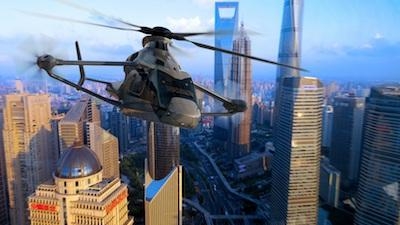Wed, Jun 21, 2017
Project Developed In The Frame Of Clean Sky 2 Research Program
Airbus Helicopters has unveiled the aerodynamic configuration of the high speed demonstrator it is developing as part of the Clean Sky 2 European research program at the Paris air show. Codenamed Racer, for Rapid And Cost-Effective Rotorcraft, this demonstrator will incorporate a host of innovative features and will be optimised for a cruise speed of more than 400 km/h. It will aim at achieving the best trade-off between speed, cost-efficiency, sustainability and mission performance. Final assembly of the demonstrator is expected to start in 2019, with a first flight the next year.

“Today we unveil our bold vision for the future of high-speed rotorcraft,” said Guillaume Faury, Airbus Helicopters CEO. “This new project, pulling together the skills and know-how of dozens of European partners through the Clean Sky 2 initiative, aims to bring increased speed and range at the right cost, thanks to a simple, safe and proven aerodynamic formula. It will pave the way for new time-sensitive services for 2030 and beyond, setting new benchmarks for high-speed helicopter transportation. ”The Racer demonstrator will be built around a simple architecture, ensuring safety and cost-efficiency. An innovative “box-wing” design, optimised for aerodynamic efficiency, will provide lift in cruise mode while isolating passengers during ground operations from the “pusher” lateral rotors designed to generate thrust in forward flight.
Optimised for performance and low acoustic signature, these lateral rotors as well as the main rotor will be driven by two RTM322 engines. An “eco mode” will be tested by the engine manufacturer to demonstrate an electrically-powered “start and stop” of one engine in flight, thus generating fuel savings and increasing range. The Racer demonstrator will also benefit from a hybrid metallic-composite airframe, specifically designed for low weight and low recurring costs. It will also be equipped with a new high voltage direct current electrical generation, which will significantly contribute to weight reduction.
Building upon the success of the self-funded X3 demonstrator, which validated the “compound” aerodynamic configuration – a combination of a traditional main rotor and innovative lateral rotors – the Racer project will bring this concept closer to an operational design and demonstrate its suitability for a wide spectrum of missions where increased speed and efficiency will bring significant added value for citizens and operators. This is especially the case for emergency medical services and search and rescue operations, as well as for public services, commercial air transport and private and business aviation.
(Image provided with Airbus Helicopters news release)
More News
He Attempted To Restart The Engine Three Times. On The Third Restart Attempt, He Noticed That Flames Were Coming Out From The Right Wing Near The Fuel Cap Analysis: The pilot repor>[...]
Make Sure You NEVER Miss A New Story From Aero-News Network Do you ever feel like you never see posts from a certain person or page on Facebook or Instagram? Here’s how you c>[...]
From 2009 (YouTube Edition): Leading Air Show Performers Give Their Best Advice for Newcomers On December 6th through December 9th, the Paris Las Vegas Hotel hosted over 1,500 air >[...]
Aero Linx: NASA ASRS ASRS captures confidential reports, analyzes the resulting aviation safety data, and disseminates vital information to the aviation community. The ASRS is an i>[...]
“For our inaugural Pylon Racing Seminar in Roswell, we were thrilled to certify 60 pilots across our six closed-course pylon race classes. Not only did this year’s PRS >[...]
 NTSB Final Report: Rutan Long-EZ
NTSB Final Report: Rutan Long-EZ ANN FAQ: Turn On Post Notifications
ANN FAQ: Turn On Post Notifications Classic Aero-TV: ICAS Perspectives - Advice for New Air Show Performers
Classic Aero-TV: ICAS Perspectives - Advice for New Air Show Performers ANN's Daily Aero-Linx (06.28.25)
ANN's Daily Aero-Linx (06.28.25) Aero-News: Quote of the Day (06.28.25)
Aero-News: Quote of the Day (06.28.25)



